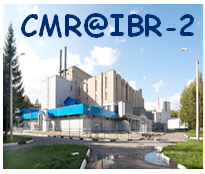Poster session II (October 14, 2020)
Link for asking questions and discussion: https://groups.google.com/d/forum/cmrposters
Soft condensed matter (biological nanosystems, lipid membranes, polymers)
48. Anghel L.L., Pectin/beta-lactoglobulin interactions observed by small-angle scattering.
49. Erhan R., Structural study of the beta-lactoglobulin - beta-glucan system using small-angle neutron scattering.
50. Avdeev M.M., Study of immobilization of polyacrylamide on oxidized silicon surface by X-ray reflectometry and atomic force microscopy.
51. Bukhdruker S.S., Crystallography and small-angle study of cytochrome P450 – redox partner electron-transfer complex.
52. Bocharov E.V., Molecular mechanisms of bitopic protein functioning revealed by structural-dynamic studies of transmembrane domain interactions.
53. Bondarev N.A., The physical and chemical characteristics of fused protein methionine γ-lyase from Clostridium Sporogenes and S-3 domain of growth factor from vaccinia virus. Not submitted
54. Gorshkova Yu.E., Biohybrid complexes with phyto-generated entities from nettle & grapes and their potential application in the biomedical field.
55. Elnikova L.V., Knotting of carbon nanotubes in isotactic polypropylene matrix due to the results of small-angle neutron scattering and lattice numerical modeling.
56. Egorov V.V., Model system for immunosuppressive peptides interaction study.
58. Erhan S.E., Secondary osteoporosis in rats studied by small angle neutron scattering.
59. Ivanova L.A., Crystal and supra-molecular structure of bacterial cellulose hydrolyzed by cellobiohydrolase from Scytalidium Candidum 3c: a basis for development of biodegradable wound dressings.
60. Kondela T., Investigation into the effect of cholesterol and melatonin on the amyloid embedded model membrane through neutron scattering.
61. Kuzmenko M.O., Support silicon oxide nanolayer for neutron reflectometry solid-liquid cell for studying biological solutions.
62. Makhaldiani N., Unified theory of dynamical systems with applications including biological systems.
63. Osipov S.D., Structural parameters of thylakoid membrane: lipid and protein parts.
64. Okhrimenko I.S., Preparation of liposomes from native cell membrane for SAXS/SANS studies.
65. Ospennikov A.S., Effect of water-soluble monomer on wormlike micelles of surfactant studied by small-angle neutron scattering.
66. Ospennikov A.S., Investigation of hydrogels based on cross-linked polymer and wormlike surfactant micelles by small-angle neutron scattering.
67. Pavlova A.A., Investigation of the domain structure of segmented polyurethane ureas by small-angle neutron scattering.
68. Ryzhykau Yu.L., SANS investigation of membrane protein oligomerization: the case of the TCS photoreceptor complex NpSRII/NpHtrII.
69. Skoi V.V., Complex effect of AgNO3 and KNO3 on DPPC bilayer: SANS AND densitometry study.
70. Aleshina A.L., PH-triggered structural transformations in the mixtures of an ionic surfactant and a hydrophilic polymer.
71. Sudarev V.V., Stability of ferritin protein complex at various pH.
72. Vlasov A.V., The possibility of dimerization of atp synthase from spinach chloroplasts.
73. Żyła A., Structural investigation interaction between amyloid-beta peptides and associated proteins the human serum albumin and human cystatin C.
Materials under extreme conditions
74. Lis O.N., The neutron diffraction study of crystal and magnetic structures of multiferroic Bi2-xFexWO6.
75. Rutkauskas A.V., The effect of doping of Sr2+ ions on the crystal and magnetic structure of barium hexaferrites Ba1-XSrXFe12O19.
76. Zel I.Yu., High pressure induced structural and magnetic phase transformations in BaYFeO4.
Texture and stress investigation of materials
77. Badmaarag A., Tensional residual strain investigation by force direction of the rebar steel sample using time-of-flight neutron diffraction at the strain/stress diffractometer EPSILON.
78. Carro-Sevillano G., Residual stress distribution after a quenching treatment obtained by neutron diffraction experiments and fem simulation.
79. Kirillov A.K., Features of the structure of the Chelyabinsk meteorite according to neutron SAS.
80. Kucerakova M., Texture study of Sinanodonta Woodiana shells by X-ray diffraction.
81. Millán L., Study of residual stresses in an extruded aluminium alloys after thermal treatments.
82. Oponowicz A., Synchrotron energy dispersive method and grazing incident X-ray diffraction used to measure stresses in surface layers of polycrystalline materials.
83. Silva P.N., Preliminary study of residual stress distribution in high strength steel wires at EPSILON neutron diffractometer.
84. Dymek S., Comparison of local and global texture in friction stir processed aluminum alloys.

